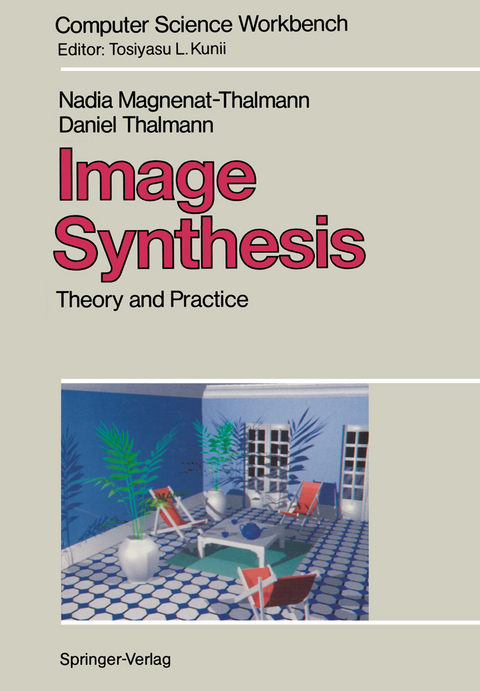
Image Synthesis
Springer Verlag, Japan
978-4-431-68062-8 (ISBN)
1 Modeling primitives.- 1.1 3D space.- 1.2 Wire-frame, surface and volume representations.- 1.3 Creating the database.- 1.4 Procedural models and data abstraction.- 2 Transformations, cameras, and colors.- 2.1 Image transformations.- 2.2 Viewing system.- 2.3 Colors.- 2.4 MIRALab virtual camera model.- 3 Free-form curves and surfaces.- 3.1 Introduction to curves and surfaces.- 3.2 Smooth interpolation by piecewise cubics.- 3.3 Coons surfaces.- 3.4 Bézier curves and surfaces.- 3.5 B-spline curves and surfaces.- 3.6 ?-spline curves and surfaces.- 3.7 Propagation control graphs.- 4 Solid modeling.- 4.1 Representation of solid objects.- 4.2 Spatial occupancy enumeration, cell decomposition, quadtrees, and octrees.- 4.3 Sweep representations.- 4.4 Constructive solid geometry.- 4.5 Boundary representations.- 4.6 Superquadrics, global and local deformations.- 4.7 Solid modeling at MIRALab.- 5 Visible surface algorithms.- 5.1 Object-space and image-space techniques.- 5.2 Essential tests for hidden-line and hidden-surface algorithms.- 5.3 Depth buffer algorithm.- 5.4 Scan-line algorithms.- 5.5 List-priority algorithms.- 5.6 Recursive subdivision algorithms.- 5.7 Algorithms for curved surfaces.- 5.8 Visible surface algorithms for solids.- 6 Illumination, shading, and transparency models.- 6.1 Introduction to illumination.- 6.2 Phong illumination model.- 6.3 Surface shading.- 6.4 Light transmission.- 7 Complex light-source and illumination models.- 7.1 Complex light sources.- 7.2 Complex reflection models.- 7.3 Interreflection between surfaces and energy equilibrium.- 8 Antialiasing and motion blur.- 8.1 Aliasing problem.- 8.2 Digital-processing convolution theory.- 8.3 Hidden-surface algorithms with antialiasing.- 8.4 Edge-inference and specific algorithms.- 8.5 Temporalaliasing and motion blur.- 9 Shadows.- 9.1 Role of shadows.- 9.2 Shadows generated during display process.- 9.3 Shadow volumes.- 9.4 Object-space polygon-clipping approach.- 9.5 z-Buffer shadows.- 9.6 Soft shadows and penumbrae.- 9.7 MIRALab implementation of shadows.- 10 Ray-tracing.- 10.1 Basic ray-tracing algorithm.- 10.2 Ray-tracing of spheres and polyhedra.- 10.3 Ray-tracing of algebraic and parametric surfaces.- 10.4 Ray-tracing of surfaces defined by sweeping.- 10.5 Depth of field and motion blur.- 10.6 Antialiasing, stochastic sampling, and distributed ray-tracing.- 10.7 Ray-tracing at MIRALab.- 11 Optimization techniques for ray-tracing.- 11.1 Survey of optimization techniques.- 11.2 Bounding volumes.- 11.3 Use of coherence in ray-tracing.- 11.4 Space division for ray-tracing.- 12 Texture.- 12.1 What is texture?.- 12.2 Methods derived from texture analysis.- 12.3 Texture mapping.- 12.4 Bump mapping.- 12.5 Solid texture.- 12.6 Ray-traced textures.- 12.7 Implementation of textures at MIRALab.- 13 Fractals and stochastic models.- 13.1 Mandelbrot fractal geometry.- 13.2 Formal approach: fractional Brownian motion.- 13.3 Random midpoint displacement algorithms.- 13.4 Other researches on fractals.- 13.5 Fractals and stochastic modeling at MIRALab.- 14 Fuzzy and soft objects.- 14.1 Phenomena modeling.- 14.2 Particle systems.- 14.3 Soft objects.- 14.4 Volume density scattering models.- 14.5 Cellular automata.- 14.6 Fuzzy objects at MIRALab.- 15 Natural phenomena.- 15.1 Synthesis of natural phenomena: a challenge.- 15.2 Representation of terrain and mountains.- 15.3 Representation of water.- 15.4 Representation of sky, atmosphere, clouds and fog.- 15.5 Representation of fire.- 15.6 Representation of trees, forests, and grass.- 15.7 Water waves, fire, clouds, and fog atMIRALab.- 16 Combination and composite images for complex 3D scenes.- 16.1 Integrated systems.- 16.2 Compositing.- 17 MIRALab image synthesis software.- 17.1 Image synthesis and animation software at MIRALab.- 17.2 INTERMIRA specification language.- 17.3 SABRINA image-synthesis system.- 17.4 Particle systems.- References.
| Reihe/Serie | Computer Science Workbench |
|---|---|
| Zusatzinfo | XV, 400 p. |
| Verlagsort | Tokyo |
| Sprache | englisch |
| Maße | 170 x 244 mm |
| Themenwelt | Informatik ► Grafik / Design ► Digitale Bildverarbeitung |
| Mathematik / Informatik ► Informatik ► Software Entwicklung | |
| Informatik ► Theorie / Studium ► Künstliche Intelligenz / Robotik | |
| Informatik ► Weitere Themen ► CAD-Programme | |
| ISBN-10 | 4-431-68062-4 / 4431680624 |
| ISBN-13 | 978-4-431-68062-8 / 9784431680628 |
| Zustand | Neuware |
| Informationen gemäß Produktsicherheitsverordnung (GPSR) | |
| Haben Sie eine Frage zum Produkt? |
aus dem Bereich


